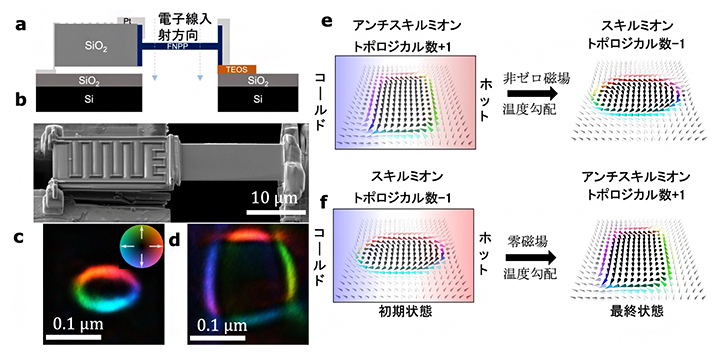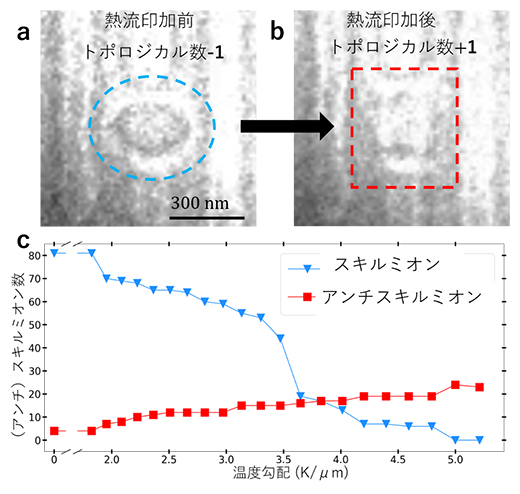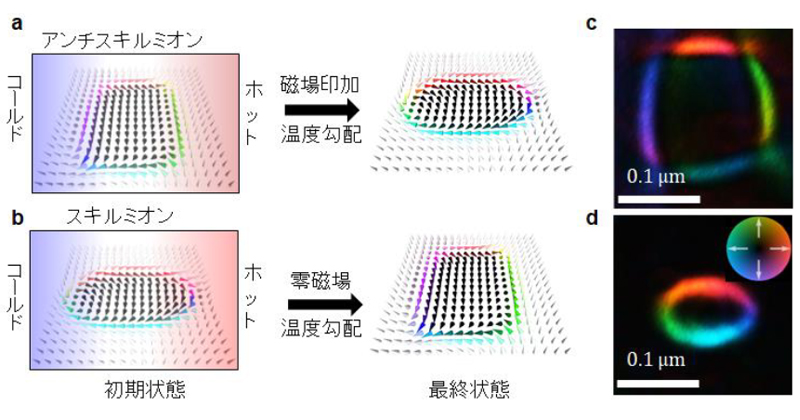November 14, 2023
Ricken
Tokyo College, Institute for Advanced Study, University of Tokyo
– It is expected to be applied to topological magnetic devices using “heat flow” –
Yasin Fayemi, Special Researcher in Basic Science, State Electron Microscopy Research Team, RIKEN Center for Emerging Materials Science, Shujin Yu, Team Leader, Daisuke Shindo, Emerging Phenomena Observation Technology Research Team Leader, Karubi, Strongly Correlated Materials Research Group Kosuke, Senior Researcher ( At the time of the research), Kojiro Taguchi, Group Director, Center Director Yoshiki Tokura (Group Director, Strong Correlation Materials Research Group, RIKEN Center for Emerging Materials Science, Distinguished Professor, University of Tokyo/Tokyo College, Institute for Advanced Study, University of Tokyo), and others, The research group uses heat flow at room temperature.Skyrmion[1]Andcom. antiskyrmion[2]Successful exchange conversion with .
The results of this research are expected to contribute to the application of skyrmions and antiskyrmions to topological magnetic devices.
So far, it has been reported that skyrmions can be driven by heat flow, but it has not been proven that heat flow can drive skyrmions or convert skyrmions into skyrmions.
This time, the research team discovered that magnetic materials (Fe0.63in0.3PD0.07)3P (Fe: iron, Ni: nickel, Pd: palladium, P: phosphorus, hereinafter referred to as “FNPP”) has a gap of about 200 nanometers (nanometer, 1 nanometer is a billionth of a meter) at room temperature and zero Magnetic field: We have succeeded in generating lluons, converting them into antinomons, and observing their dynamic behavior. Furthermore, the research group confirmed that it is possible to convert anticrystallizations into skyrmions by applying a heat flux due to the temperature gradient to the anticrystallizations generated in the FNPP thin plate by applying an external magnetic field.
The results of this research were published in the electronic scientific journal “Nature Communications“(Dated November 4).
Interconversion between heat flow-induced skyrmions and antiskyrmions in magnetic FNPP
background
“Skyrmion” is a solid materialElectron spin[3]It is a helical magnetic structure consisting ofTopological number[4](-1) and behaves as a stable particle. In addition to their small size, typically between tens and hundreds of nanometers (nm, 1 nanometer = 1 billionth of a metre), they can be operated at low current, so they are expected to be used in energy-efficient devices.
On the other hand, an “antiskyrmion” is an anti-vortex magnetic structure that has a topological number (+1) with a sign opposite to that of the skyrmion, so it is considered an antiskyrmion particle and attracts attention as a new topological structure.
Previously, it has been shown that skyrmions can be driven by heat flow due to thermal gradients.Note 1)However, it has not been confirmed that anti-solidification processes are driven by heat flow.
Research methods and results
The research group used the magnetic material FNPP, which can generate skyrmions and anti-skyrmions at room temperature, to observe the dynamic behavior of skyrmions and anti-skyrmions under real-space heat flow.
First, a 150 nm FNPP thin sheet was formed. Then, a heater wire (Pt) was connected to the silicon dioxide thin plate, and the silicon dioxide thin plate was contacted with one end of the FNPP thin plate. Then, the insulating material “TEOS” was connected to the silicon dioxide thin plate kept at room temperature, and the “TEOS” was brought into contact with the other end of the FNPP thin plate (Figure 1a, b). . By passing current through the heater wire, it is possible to create a temperature gradient from high temperature to low temperature in the FNPP thin plate from the conduction portion of the silicon dioxide thin plate to the TEOS conduction portion.
By applying a 450 milliTesla (mT) magnetic field perpendicular to the FNPP thin plate and then gradually lowering the magnetic field to zero, we were able to generate skyrmions in the FNPP thin plate (Figure 1c). Next, a current is passed through the heater wire, and Note the change in skyrmions.Lorentz electron microscopy[5]As observed in the FNPP thin plate, the skyrmions started to transform into antiparallels (Fig. 1d) with increasing temperature gradient in the FNPP thin plate (Fig. 1f). Then, when we applied a magnetic field of 439 mT perpendicularly to the FNPP thin plate and varied the temperature gradient, the antioxidants turned into skyrmions due to the heat flux (Fig. 1e).

Figure 1: Devices made from FNPP thin sheets and experimental results using the devices
- (a)Schematic drawing of a small device created from thin sheets of FNPP.
- (B)Scanning electron micrograph of a small device.
- (c)In-plane magnetic field distribution of a single skyrmion generated in a small device at room temperature.
- (Dr)In-plane magnetic field distribution of a single antidote generated in a small device at room temperature.
- (e)Conversion of antioxidants into skyrmions by temperature gradient heat flow in a magnetic field.
- (F)Skyrmion to antiskyrmion conversion via temperature gradient heat flow in zero magnetic field.
After generating skyrmions in the FNPP thin plate, we studied the relationship between the temperature gradient and the number of skyrmions and antiskyrmions. The temperature gradient is 5.0Kμm-1(K/μm), all skyrmions were found to convert to antiskirmions (Fig. 2c).

Figure 2: Conversion from topological number -1 to +1 due to heat flow
- (a)Lorentz electron micrograph of a skyrmion before the application of heat flux due to the temperature gradient.
- (B)Lorentz electron micrographs of the counterions after the application of heat flux due to a temperature gradient
- (c)Graph showing the number of skyrmions (blue) and anti-skirmions (red) as the temperature gradient changes.
Future expectations
In this study, we succeeded for the first time in controlling the interconversion between antioxidants and skyrmions by heat flow at room temperature and in a zero magnetic field. The results of this research make it possible to control the topological number using the “heat flow” generated by different processes. The topological numbers (+1,-1) here can correspond to (0,1) in electronic devices, which will contribute to the development of topological magnetic devices in the future.Spintronics[6]This is expected to be useful for applied research.
Supplementary explanation
- 1.Skyrmion
It is a helical magnetic structure formed by the spin of an electron in a solid, and has a topological number of -1. The linear rotation arrangement that passes through the center of the Skyrmion has the same spiral shape no matter where it is cut. The rotation matrix and the external rotation matrix are antiparallel, and the rotation matrix between them is arranged in a spiral shape with the direction changing little by little. - 2.com. antiskyrmion
An anti-vortex magnetic structure with topological number “+1” of opposite sign to the skyrmion. The rotation arrangement on a straight line passing through the center of the anticrystallization alternates between helical and circular shapes each time it rotates in the plane by 45 degrees, and the direction of rotation reverses each time it rotates by 90 degrees. - 3.Electron spin
One of the degrees of freedom that electrons have, and they act like little magnets. This can be understood as the rotation of electrons. - 4.Topological number
The topological number is a number that corresponds to the “turn number” of the spin, which characterizes the geometric properties of the magnetic vortex, and measures how much the spin itself rotates (spins) during one revolution (turn) around a circle. The number representing topology is a mathematical concept and is the branch of mathematics that discusses the shape of objects, including their stability to constant deformation. - 5.Lorentz electron microscopy
A microscope observes the magnetic structure within a sample by visualizing changes in the direction of electron paths due to the Lorentz force that an electron beam receives when it passes through a magnetic material. - 6.Spintronics
Electronic engineering that uses the phenomenon of electron spin (spin). It is expected to provide an operating principle for next-generation non-volatile, energy-efficient electronic devices.
Research support
This research is supported by the Japan Society for the Promotion of Science (JSPS) Grant for Scientific Research (A), “Real-space observation of topological spin structures and their dynamics using electron microscopy (Principal Investigator: Yu Xiu-Jin, 19H00660).” (S) “New Electromagnetic Induction Emerging in Magnetic Conductors (Research Representative: Yoshinori Tokura, 23H05431),” Japan Science and Technology Agency (JST) Strategic Creative Research Promotion Project CREST “Creating New Topological Magnetic Sciences Aiming for Beyond Skyrmion” (Principal Investigator : Xiujin Yu, JPMJCR20T1)” and “Electronic Quantum Phase Control Using Nanospin Structure (Principal Investigator: Naoto Naganaga, JPMJCR1874).”
Original paper information
- Fahmi Sami Yassin, Jean Maciel, Kosuke Karubi, Daisuke Shindo, Yasujiro Taguchi, Yoshinori Tokura, Chiozhen Yu, “Topological spin texture transitions driven by thermal current and q-vector helical switching”, Nature Communications, 10.1038/s41467-023-42846-7
Presenter
Ricken
Electron Microscopy Research Group Research Center for Emerging Materials Sciences
Basic Science Research Fellow Fahmi Sami Yassin
Team leader Wu Shuchen
Emerging Phenomena Observation Technology Research Team
Team leader Daisuke Shindo
Strongly Correlated Materials Research Group
Senior researcher (at time of research) Kosuke Karubi
Group Director Kojiro Taguchi
Center for Emerging Materials Science Research
Center Director Yoshinori Tokura
(Group Director, Strongly Connected Materials Research Group, Emerging Materials Science Research Center, Distinguished Professor, University of Tokyo/Tokyo College, Institute for Advanced Study, University of Tokyo)
Press attaché
Public Relations Office RIKEN Press Office
Inquiry form
Tokyo College Team, Department of International Strategy, Department of Institutional Planning, University of Tokyo
Tel: 080-9673-4196 / Fax: 03-5841-3409
Email: tokyo.college.adm [at] gs.mail.u-tokyo.ac.jp
Inquiry regarding industrial use

“Travel maven. Beer expert. Subtly charming alcohol fan. Internet junkie. Avid bacon scholar.”





![“Pikmin Bloom” Find the differences in honor of Children's Day!! Trump's status report is so useless that you can't help but laugh[Playlog #621]|. Famitsu application[موقع معلومات ألعاب الهاتف الذكي]](https://app.famitsu.com/wp-content/uploads/2024/05/8b2c6bdec98dc30711a5e845d65a4eb9-506x254.jpg)

More Stories
League of Legends (LoL), TPM 2.0 is required for Windows 11. Players who do not support TPM 2.0 will eventually need to replace their PC.
“Pikmin Bloom” Find the differences in honor of Children's Day!! Trump's status report is so useless that you can't help but laugh[Playlog #621]|. Famitsu application[موقع معلومات ألعاب الهاتف الذكي]
The Crew Dragon spacecraft moves on the International Space Station in preparation for the arrival of the Sorae space gate site